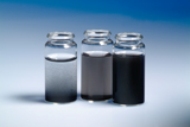Oct 1 2010
These days, plastic components are vital to many fields of industry – lightweight construction, automobile manufacturing and electrical engineering, to name but a few. Now researchers have found ingenious ways to combine plastics with nanoparticles and endow them with new properties. Thanks to these innovative materials, aircraft could in future be better protected against lightning strikes.
Picture the scene: Pitch-black clouds gathering on the horizon, an aircraft winging its way towards the storm … and suddenly a flash of white-hot lightning splits the sky. It is by no means a rare occurrence for aircraft to have to pass through bad weather fronts, but when they do, there is always one major danger – lightning. Naturally, aircraft manufacturers do everything they can to protect their machines against strikes, but even aircraft made of aluminum do not always escape entirely unscathed. And when polymer components – usually carbon fiber reinforced plastics (CFRPs) – are incorporated into the design as a weight-saving measure, the situation becomes even more problematic, because they do not conduct electrical current as well as aluminum.
 At the Fraunhofer Institute for Manufacturing Technology and Advanced Materials IFAM in Bremen, researchers have now developed a process for manufacturing new materials that should afford aircraft better protection against lightning strikes.
At the Fraunhofer Institute for Manufacturing Technology and Advanced Materials IFAM in Bremen, researchers have now developed a process for manufacturing new materials that should afford aircraft better protection against lightning strikes.
At the Fraunhofer Institute for Manufacturing Technology and Advanced Materials IFAM in Bremen, researchers have now developed a process for manufacturing new materials that should afford aircraft better protection against lightning strikes. They have been focusing on the unique material properties of carbon nanotubes (CNTs). CNTs are among the stiffest and strongest fibers known, and have particularly high electrical conductivity. In order to transfer their properties to CFRPs, the scientists have been combining these nanoparticles with plastics. “By mixing nanoparticles with plastics, we’ve been able to significantly enhance the material properties of the latter,” states Dr. Uwe Lommatzsch, project manager at the IFAM. To give just two examples, CNTs are being used to optimize the electrical conductivity of plastics, and their heat dissipation properties are likewise being improved by the addition of metal particles.
The trick is in the mixing process, says Lommatzsch: “The micro- or nanoparticles must be highly homogeneous, and sometimes very closely bound to the polymer.” To do this, the scientists employ plasma technology. They use an atmospheric plasma to alter the surface of the particles in such a way that they can be more readily chemically bound with the polymer. A pulsed discharge in a reaction chamber creates a reactive gas. Lommatzsch’s colleague, Dr. Jörg Ihde, explains: “We spray the particles – i.e. the nanotubes – into this atmospheric plasma.” They immediately fall into the selected solvent, which can then be used to further process the polymer. The whole procedure takes just a few seconds – a huge advantage over the old method, in which CNTs were generally prepared in an acid bath using a wet chemical process. That took several hours or days, required considerably more chemicals, and generated significantly more waste.
Source: http://www.fraunhofer.de/